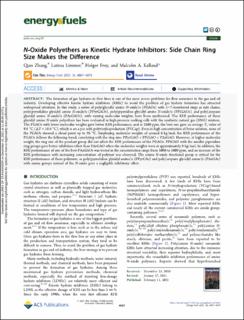| dc.contributor.author | Zhang, Qian | |
| dc.contributor.author | Limmer, Larissa | |
| dc.contributor.author | Frey, Holger | |
| dc.contributor.author | Kelland, Malcolm Andrew | |
| dc.date.accessioned | 2023-02-17T12:17:55Z | |
| dc.date.available | 2023-02-17T12:17:55Z | |
| dc.date.created | 2021-12-08T15:35:37Z | |
| dc.date.issued | 2021 | |
| dc.identifier.citation | Zhang, Q., Limmer, L., Frey, H., & Kelland, M. A. (2021). N-oxide polyethers as kinetic hydrate inhibitors: Side chain ring size makes the difference. Energy & Fuels, 35(5), 4067-4074. | en_US |
| dc.identifier.issn | 0887-0624 | |
| dc.identifier.uri | https://hdl.handle.net/11250/3051949 | |
| dc.description.abstract | The formation of gas hydrates in flow lines is one of the most severe problems for flow assurance in the gas and oil industry. Developing effective kinetic hydrate inhibitors (KHIs) to avoid the problem of gas hydrate formation has attracted widespread attention. In this study, a series of poly(glycidyl amine N-oxide)s (PGAOs) with 5–7-membered rings as side chains, poly(pyrrolidine glycidyl amine N-oxide)s (PPyrGAOs), poly(piperidine glycidyl amine N-oxide)s (PPiGAOs), and poly(azepane glycidyl amine N-oxide)s (PAzGAOs), with varying molecular weights, have been synthesized. The KHI performance of these glycidyl amine N-oxide polyethers has been evaluated in high-pressure rocking cells with the synthetic natural gas (SNG) mixture. The PGAOs with lower molecular weights gave better KHI performance, and at 2500 ppm, the best one gave an average To value of 9.8 °C (ΔT = 10.4 °C), which is on a par with polyvinylcaprolactam (PVCap). Even in high concentration of brine solution, none of the PGAOs showed a cloud point up to 95 °C. Employing molecular weights of around 4 kg/mol, the KHI performance of the PGAOs follows the following trend, correlating with the ring size: PPyrGAO < PPiGAO < PAzGAO. However, at higher molecular weight, the ring size of the pendant group did not affect the KHI performance of the PGAOs. PPiGAO with the smaller piperidine ring groups gave better inhibition effect than PAzGAO when the molecular weights were at approximately 8 kg/mol. In addition, the KHI performance of one of the best PAzGAOs was tested in the concentration range from 1000 to 5000 ppm, and an increase of the KHI performance with increasing concentration of polymer was observed. The amine N-oxide functional group is critical for the KHI performance of these polymers, as poly(pyrrolidine glycidyl amine)s (PPyrGAs) and poly(azepane glycidyl amine)s (PAzGAs) with amine groups instead of the N-oxide gave a negligible inhibitory effect. | en_US |
| dc.language.iso | eng | en_US |
| dc.publisher | American Chemical Society | en_US |
| dc.rights | Navngivelse 4.0 Internasjonal | * |
| dc.rights.uri | http://creativecommons.org/licenses/by/4.0/deed.no | * |
| dc.title | N‑Oxide Polyethers as Kinetic Hydrate Inhibitors: Side Chain Ring Size Makes the Difference | en_US |
| dc.type | Peer reviewed | en_US |
| dc.type | Journal article | en_US |
| dc.description.version | publishedVersion | en_US |
| dc.rights.holder | The authors | en_US |
| dc.subject.nsi | VDP::Matematikk og Naturvitenskap: 400 | en_US |
| dc.source.pagenumber | 4067-4074 | en_US |
| dc.source.volume | 35 | en_US |
| dc.source.journal | Energy & Fuels | en_US |
| dc.identifier.doi | 10.1021/acs.energyfuels.0c04333 | |
| dc.identifier.cristin | 1966330 | |
| cristin.ispublished | true | |
| cristin.fulltext | original | |
| cristin.qualitycode | 2 | |

